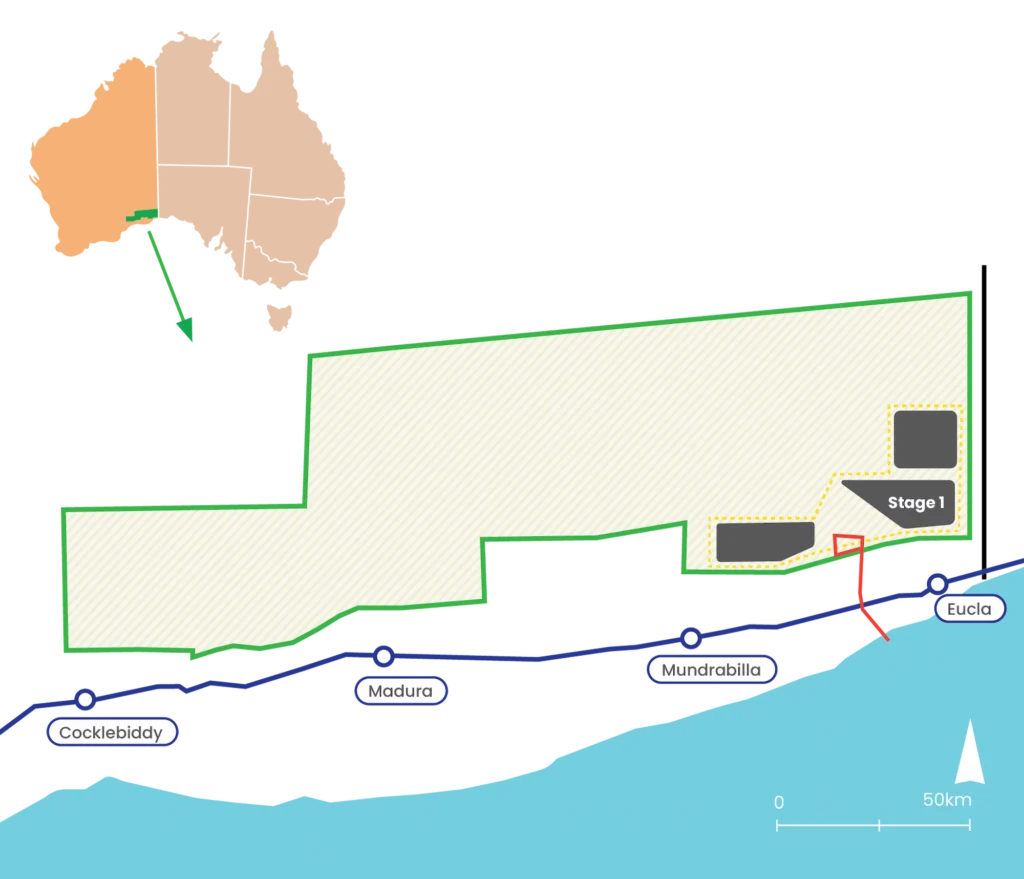Project Overview
Sited on the Hampton Tablelands with advantageous wind and sun profiles
WGEH is a multi-phased wind, solar and green hydrogen development, located on Mirning traditional lands in the south-east corner of Western Australia, across the Shire of Dundas and the City of Kalgoorlie-Boulder.
The area is an undulating tablelands and has advantageous diurnal profiles of untapped wind and sun.
A project
built in phases
In its first phase, the WGEH project will generate up to 8GW of hybrid wind and solar power, about as much as the total solar power presently sitting on Australian rooftops.
This energy will be used to produce up to 500Ktpa of zero-carbon green hydrogen.
The fully phased WGEH project will produce around 3.5 Mtpa of green hydrogen, to be made available for use in power generation, supply of shipping fuel, minerals processing and heavy transport.
Local and regional power and water supply options would also be available.
Key
-
Eyre Hwy
-
WA/SA Border
Please hover over hot spots to reveal more information.

Downstream & Workshops
Marine Offloading Facility,
Ammonia Export
& Desalination
Project Infrastructure Corridor
What will the
project look like?
The WGEH project will be built over a number of consecutive phases and operate for many decades. It was awarded Lead Agency status by the WA Department of Jobs, Tourism, Science and Innovation in December 2021 and an application for Commonwealth Major Projects status is currently being prepared.
A ‘Concept Feasibility Study’ was recently completed to better understand the broad specifications of the project and associated land use.
Under current plans, the project will comprise:
- Wind and solar power generation and electrolysis assets, together with appropriate electrical and hydrogen connection infrastructure;
- A downstream and processing area where the green hydrogen produced will be converted into green fuels and possibly used and/or sold for various value-added products; and
- Supporting/service infrastructure, including a marine offloading facility (MoF), desalination facilities, and dedicated regional hubs, including workforce, residential and commercial facilities.
It is anticipated that many of the inputs for required project infrastructure, equipment and other assets will be manufactured at site, supported by using the existing trans-continental highway and rail, and a new MoF.
What is going on at
the site right now?
As part of the early project development phase, WGEH has been conducting onsite monitoring and surveys, some required for business decision-making, some to satisfy government statutory process.
Critical wind and solar monitoring equipment has been installed to collect real time data. A minimum 12 months’ monitoring is required to properly assess the site’s wind and solar resource.
Environmental studies continue across the full site, including sampling and assessment of flora and fauna habitats and the assessment of the occurrence of significant flora and fauna. These studies also include the marine environment, where oceanographic and biodiversity studies have taken place.
Cultural heritage work is also continuing with Mirning traditional owners and knowledge holders who, as custodians of the land on which the project is to be situated, have deep spiritual and heritage connections. Importantly, this work will recognise highly sensitive and protected areas (including Tjukurpa – song lines), where no development will take place.
Both sets of information are presently under-represented in State databases. WGEH-related assessments will add new scientific, cultural, landscape and environmental information for broader use.
